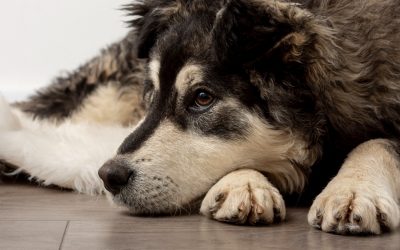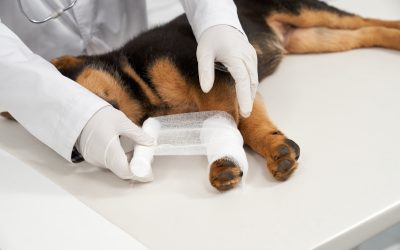Intervertebral Disc Herniation Symptoms & Treatment [Guide]

Updated Jan 28, 2025
Intervertebral Disc Disease (IVDD) in dogs is a condition that affects the cushioning discs between the vertebrae in a dog’s spine, leading to pain, discomfort, and sometimes neurological complications. IVDD is a common spinal disorder that can affect dogs of all breeds and ages, although certain breeds are more predisposed to it. Understanding its causes, recognizing early signs, and knowing the available treatment options can help you provide the best care for your canine companion.
Understanding the Anatomy of the Intervertebral Disc
intervertebral discs act as shock absorbers between the vertebrae, allowing for flexible movement along the spine. Each disc is made up of a tough outer layer, the annulus fibrosus, and a gel-like inner core, the nucleus pulposus.
Intervertebral discs play a crucial role in spinal stability, enabling movement and absorbing the impact of daily activities. When these discs degenerate or herniate, they can put pressure on the spinal cord or nerves, leading to the symptoms of IVDD.
Common Causes of IVDD in Dogs
Several factors contribute to IVDD in dogs, including:
- Genetics: Certain breeds like Dachshunds, Basset Hounds, Shih Tzus, French Bulldogs, and Pekingese are more prone to IVDD because of their elongated spines and specific disc structures.
- Age: As dogs age, their intervertebral discs naturally degenerate, making them more susceptible to bulging or herniation.
- Obesity: Extra weight puts additional stress on the spine, increasing the risk of disc issues.
- Trauma: Injuries, such as falls or collisions, can cause sudden disc herniation or rupture.
- Repetitive Stress: Activities that involve repetitive movements, like jumping or excessive stair climbing, may increase the risk of IVDD.
Recognizing the Early Signs and Symptoms of IVDD in Dogs
Common symptoms to watch for include:
- Pain and Discomfort: Your dog may vocalize, avoid movement, or show signs of pain when touched in certain areas.
- Anxiety and Reluctance to Walk: Dogs in pain may appear anxious, hesitant to walk, or struggle to get up.
- Limping and Lameness: Limping, dragging hind legs, or favoring one side could indicate spinal discomfort.
- Difficulty Pooping: Your dog may struggle to assume the proper position to defecate due to pain.
- Weakness or Paralysis: Severe pain or nerve compression can cause weakness or paralysis in the limbs, making it hard for your dog to move properly.
- Incoordination or Wobbliness: Unsteady movements, staggering, or difficulty walking could signal spinal issues or nerve problems.
- Avoiding Stairs and Furniture: Pain may cause your dog to avoid jumping, climbing stairs, or getting on furniture they normally would.
- Arching the Back: Your dog may arch their back like a cat to avoid further pressure on the spine.
- Muscle Spasms or Tremors: Involuntary muscle contractions can occur with nerve compression or pain.
- Refusal to Eat: Pain, particularly in the neck or back, can lead to a loss of appetite or refusal to eat.
- Looking Drunk While Walking: Lack of coordination or stability can make your dog seem unbalanced or “drunk” while walking.
Diagnosing IVDD in Dogs: Tests and Examinations
If IVDD is suspected, your vet may recommend tests to confirm the diagnosis and evaluate the severity of the condition. These tests may include:
- X-rays: Useful for identifying vertebral alignment and disc issues.
- Myelography: A contrast dye is injected into the spinal canal to highlight disc problems.
- CT Scan: Provides detailed images of the spine to assess disc herniation.
- MRI: Considered the gold standard for IVDD diagnosis, offering highly detailed images of the spine.
- Neurological Exam: Your vet will check reflexes, muscle tone, and sensory perception.
Types of IVDD: Type I vs. Type II
IVDD is classified into two main types:
- Type I (Hansen Type I): Common in chondrodystrophic breeds (e.g., Dachshunds, Basset Hounds, Shih Tzus), this type involves sudden, acute disc herniation and can lead to severe pain or neurological issues.
- Type II (Hansen Type II): Seen more often in non-chondrodystrophic breeds, this type results from chronic disc degeneration and gradual spinal cord compression.
Breeds at Higher Risk for IVDD
While IVDD can affect any dog, some breeds are more predisposed due to their physical characteristics:
- Dachshunds: Due to their elongated spines, Dachshunds are particularly vulnerable to IVDD.
- Basset Hounds: Their long backs put them at increased risk.
- Shih Tzus: With their long backs and short legs, they’re also prone to IVDD.
- Pekingese: Their compact bodies and short legs make them susceptible.
- Beagles: While less commonly affected than some breeds, Beagles still have a higher risk compared to many other breeds.
Treatment Options for IVDD
As described by Dr. Attas in the American Kennel Club’s article: ‘Since there are many factors involved in causing IVDD, the treatments tend to vary as well. “The one thing we can’t do is ignore it,” Dr. Attas emphasizes. “A minor problem that could be completely fixed with rest and anti-inflammatory medication can become a much more serious problem if people don’t pay attention to it.”
Cervical IVDD is especially concerning because damage so high up in the spinal cord will affect more than just the dog’s hind limbs. Surgery in this location tends to be more complicated and carries greater risks to the dog if it doesn’t go as planned. “Often times a traumatic injury in the cervical region can be a life-ending situation,” Dr. Attas says.
For some dogs, the chance to run and jump is just too tempting, even when they’re in pain. If they have a disk that is mildly inflamed or partially extruded, what they really need is rest. Your vet may prescribe anti-inflammatory drugs to reduce pain and inflammation. These medications can be steroidal or non-steroidal, but you should use them only as directed by your vet.’
Rehabilitation and Physical Therapy
Whether treated surgically or non-surgically, physical therapy is crucial to your dog’s recovery. It can:
- Improve Mobility: Exercises help restore movement and muscle strength.
- Manage Pain: Techniques like cold/heat therapy, massage, and electrical stimulation can ease pain.
- Prevent Future Injury: Strengthening core muscles supports the spine and reduces the risk of further damage.
- Enhance Quality of Life: A rehabilitation program can help your dog regain independence and improve function.
Preventing IVDD in Dogs
While IVDD can’t always be prevented, especially in genetically predisposed breeds, these strategies can help reduce the risk:
- Maintain a Healthy Weight: Reducing strain on the spine lowers the risk of disc degeneration.
- Low-Impact Exercise: Activities like swimming or walking are less stressful on the spine.
- Limit Jumping and Stair Climbing: These activities can contribute to disc degeneration.
- Use Ramps or Stairs: Help your dog access elevated surfaces safely.
- Proper Nutrition: A balanced diet supports strong bones and muscles.
- Orthopedic Bedding: Supportive bedding can relieve spinal pressure during rest.
Living with a Dog with IVDD
If your dog has been diagnosed with IVDD, creating a supportive environment is key. Here are some tips:
- Create a Safe Resting Space: Provide a quiet, comfortable place for your dog to rest, with accessible bedding and ramps for mobility.
- Manage Activity: Follow your vet’s advice on limiting activity and reintroducing exercise as your dog recovers.
- Assistive Devices: Depending on the severity, harnesses, slings, or even wheelchairs may help with movement.
- Monitor Changes: Keep a close eye on your dog’s condition and notify your vet if you notice changes in behavior or mobility.
- Seek Support: Caring for a dog with IVDD can be challenging, so don’t hesitate to reach out for help from family, friends, or support groups.
How Can Pet Insurance Help You if Your Dog Got Herniated Discs?
Pet insurance can be a valuable tool in managing the costs of treating a dog’s veterinary expenses. By having a pet insurance policy in place, you can have peace of mind knowing that you can provide medical care for your furry companion without worrying about the financial burden. Pet insurance can help cover the costs of veterinary consultations, diagnostic tests, medications, and even specialized treatments if required.
Reimbursement
This method is the most common for pet insurance companies. You pay out of pocket for the veterinarian bill, and then the insurance company reimburses you for what’s covered under the insurance plan. The steps look like this:
- You pay the vet bill after your dog’s visit.
- You fill out the pet insurance claim form.
- Submit the claim form and other required documentation to the insurer.
- After the claim is approved, you will be reimbursed for eligible expenses.
What Does Odie Pet Insurance Cover?
Pet insurance covers various veterinary expenses, providing financial protection and peace of mind for pet owners. Here are the details of the coverage options offered by Odie Pet Insurance:
Illness & Injury Plan
The Illness & Injury Plan is an all-inclusive insurance plan designed to cover a wide range of medical needs for your pet. This plan includes comprehensive coverage for various illnesses, injuries, and veterinary services. Some of the covered items include:
- Veterinary exams and consultations
- Diagnostics (e.g., X-rays, lab tests)
- Prescribed medications
- Surgeries and hospitalization
- Rehabilitation, acupuncture, or chiropractic treatments
- Medically necessary supplies
- Euthanasia and cremation
The Wellness Plan
The Wellness Plan is a monthly membership that focuses on preventive care and covers routine veterinary services.
- Provides reimbursements for routine care items such as wellness visits (exams and vaccines), testing and parasite prevention, dental cleanings and at-home dental care, vitamins, supplements, and more.
- Through Odie’s partnership with Petivity, a leader in smart pet products and proactive care, Wellness Plan members can also receive reimbursements for Petivity devices and health kits, as well as eligible Purina food and supplements.
- Total reimbursement up to $700 per year.




